More than a few friends and family members have asked what it was like living as a bonsai apprentice in Japan for 6 weeks. Some days were filled with mochi parties and antique shows. Other days involved lifting, carrying, and more lifting. There was a lot of sitting in the car as we drove as far as Tokyo and Takamatsu, and there was a lot of second hand smoke.
As much as I lived the day-to-day life of a bonsai apprentice, I was a short-timer, and this helped keep my spirits high throughout my visit. I don’t pretend to know what it’s like for Peter Tea or the other Americans studying bonsai abroad. Fortunately for us, they’re doing a great job writing about their experiences.
Peter started the Aichi-en Apprenticeship Program to expose more people to the bonsai life. So far at least four of us have stayed with the Tanakas in their Nagoya home.

Apprentice quarters at Aichi-en
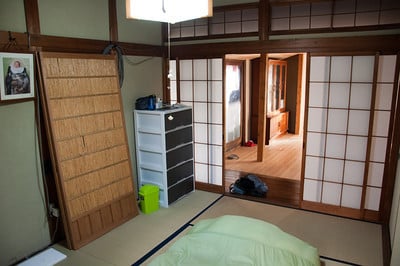
The sum of my furniture: futon, comforter, storage unit, rubbish bin
You’ll notice that the sliding doors and walls offered very little privacy. At any time, the Tanaka’s boys would peek inside to say hi, see if I could play, or stop by for an impromptu computer lesson.
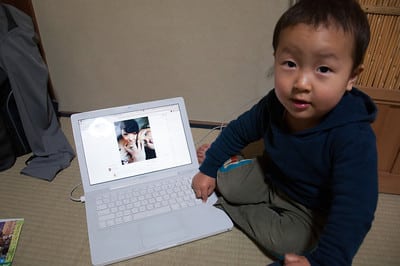
The industrious Hiyuu navigating Facebook
I was fortunate that Peter had been at Aichi-en for seven months when I arrived – plenty of time for him to learn the routine and improve his already considerable bonsai skills. His comfort at Aichi-en insured my comfort there.
Each morning we ate breakfast with the family and then headed out into the sea of bonsai surrounding the house.
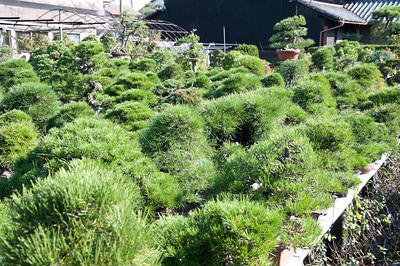
Sea of bonsai
We spent much of our time in the workshop. Mr. Tanaka sat just inside the door – I sat to his right, then Peter, and finally the other Mr. Tanaka, a third-year apprentice, sat at the far end of the workshop. Some days were quiet, others were chatty. Snacks appeared around 10:30 and 3:30 each day, as did lunch and dinner at fairly predictable times. What was not predictable, however, was how much time we got to spend in the workshop.
I visited Aichi-en in Fall – show season. This meant that we spent a lot of time with show-related activities that included picking up trees from customers, preparing trees for exhibits, and setting up and later striking the actual exhibits.
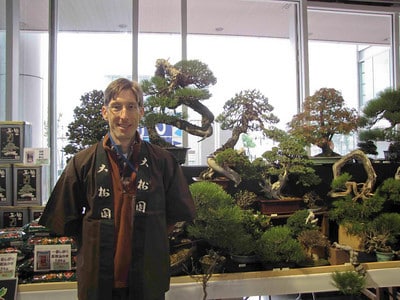
At the Daiju-en sales area, part of the 11th Asia-Pacific Bonsai and Suiseki Convention and Exhibition held in Takamatsu
Fall is also pine season. When we weren’t doing exhibit-related work, pines filled the workshop.
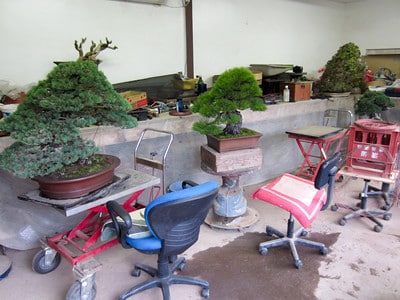
Aichi-en workshop
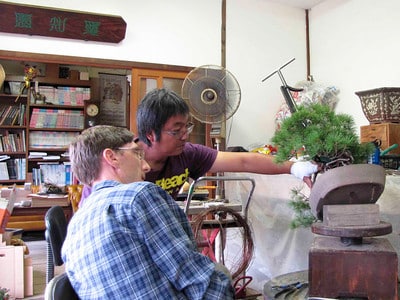
Mr. Tanaka and me appraising a white pine
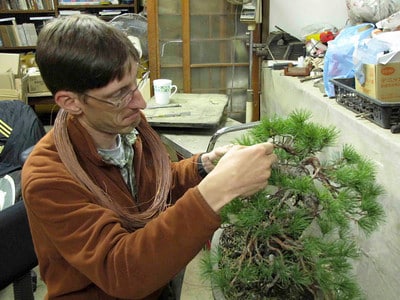
Debatable wiring technique
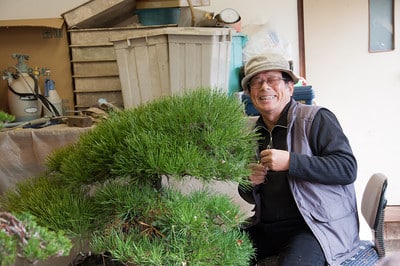
The intrepid Mr. Tanaka – no relation to the boss
Workshop time doesn’t necessarily equate to bonsai time. Peter, apprentice-Tanaka, and I, cleaned the workshop every day and performed tasks that varied from packing boxes to painting display stands. The same was true for Mr. Tanaka. His work came to a halt whenever customers visited, and evenings were often filled with projects like the fabrication of root stands.
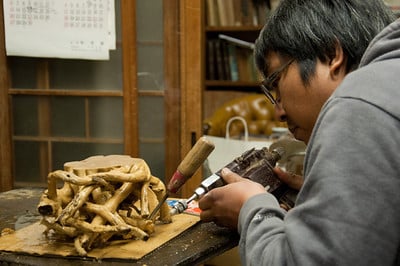
Mr. Tanaka at work on a root stand
One apprentice-related topic that deserves special attention is food. It’s one thing to have little control over one’s time. It’s another to have little control over what, and how quickly, one must eat.
I was fed very well and I missed the food the day I returned home. But because we had so little control over what, where, and when we ate, our free time often focused on food.
On those special occasions when we had time off – maybe one day per 10-20 days – we often headed across a busy street to a mall that had a great grocery store. Peter and I picked out everything that looked good and then spent the rest of the day snacking. Treats ranged from the healthy, including Japan’s outstanding – and expensive – produce, to all manner of things fried.
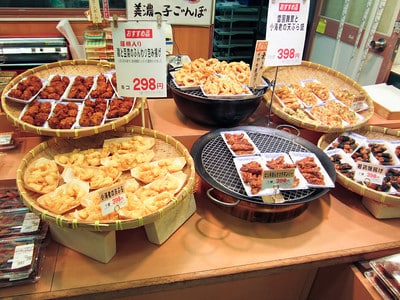
Fried treats at the local grocery
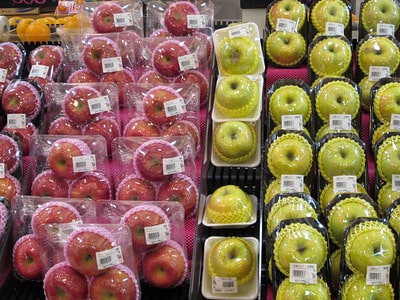
Amazing apples – only $7 for three!
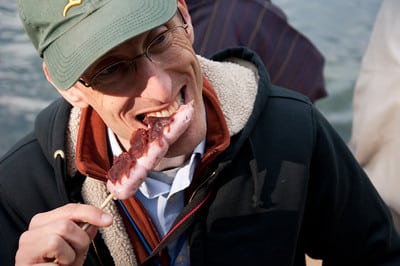
Roasted cherry-flavored mochi with red bean paste
The meals rarely left me hungry – the Japanese develop great appetites at an early age.
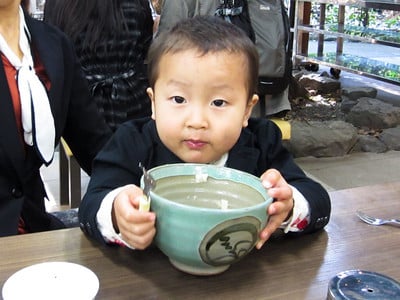
What are you looking at?
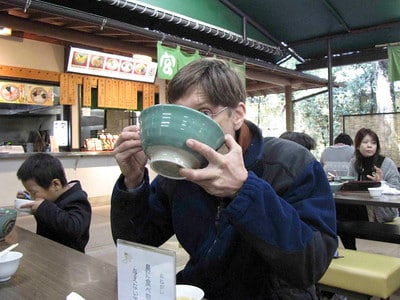
Finding the bottom of the udon bowl
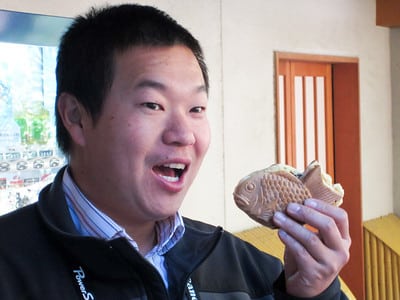
Peter vs the Taiyaki – waffle batter with red bean paste inside
Our precious days off gave us the opportunity to catch up with friends or with blog posts, explore the neighborhood, or simply sleep. Mundane activities included laundry. Peter and I used the Tanakas’ washing machine, but dried our clothes at a laundromat a few blocks away. In one of the more surreal moments of my visit to Japan, I found myself alone with a uniformed laundry attendant vacuuming beneath the dryers on her hands and knees while the Carpenters sang their greatest hits.
Days off also provided social time with the Tanaka family. One day we headed to the oldest Temple in Nagoya to participate in a service for young boys, of which the Tanakas have three.
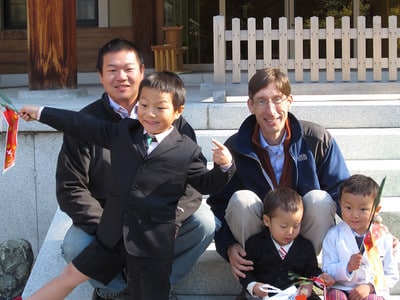
The Aichi-en children
Afterwards, we visited an open house hosted by the man who built the Tanaka’s residence.
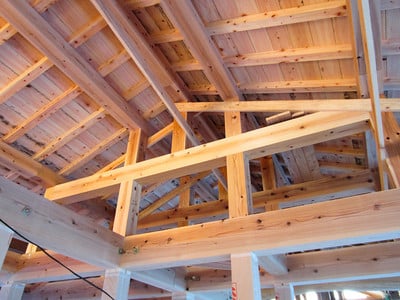
Traditional Japanese home – hinoki and sugi
We also had a little free time in the mornings before Mr. Tanaka came out to the workshop. I typically walked around appreciating the trees – and pots, of which Aichi-en had plenty.
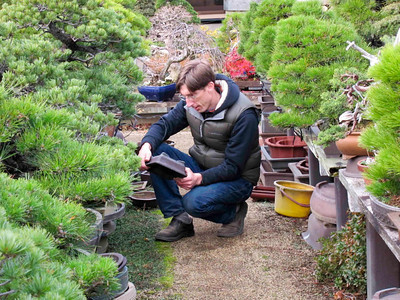
Hmm, Japanese, 40 years old – maybe just the thing for that pine back home
Above all, I can say the time spent with Peter and the Tanakas was great fun. I learned a lot and had a wonderful time along the way. I sincerely appreciate the effort Peter and the Tanakas took to ensure I had a great trip – if any of you are reading this, thanks again!
On my last evening, Mr. Tanaka presented me with a certificate for completing 6 weeks of study at his nursery. To celebrate, we headed into town and visited a driving range!
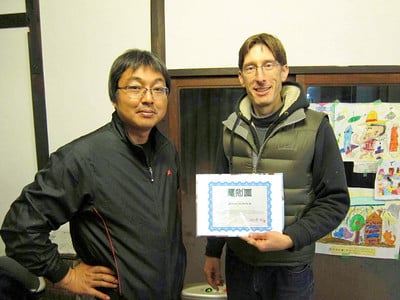
Here’s the paper – now on with the party
Of course, it was early December in Nagoya – not the warmest time of the year, but as good a time as any for golf, a sport which all three of us – Mr. Tanaka, Peter and myself – have neglected in recent years due to our obsession with bonsai.
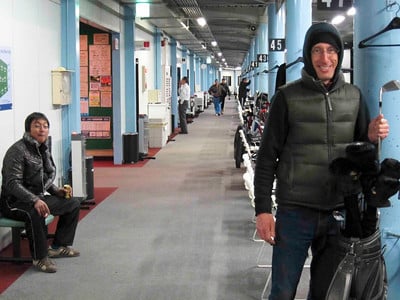
Mr. Tanaka armed against the cold with cigarette and coffee – me with hoodie and 5-iron
The driving range was pretty incredible. After striking a ball, the tee dipped below the artificial grass and arose with another ball in place – there was no bending over at this range. And the vending machine that provided us with the cards used to magically dispense balls proved to be the most thoughtful vending machine I’ve seen. The text reads, “CARD: This machine represents pleasant feeling with simple form and fresh color patterns. Glory producing machine by respecting convenience of users and others.”
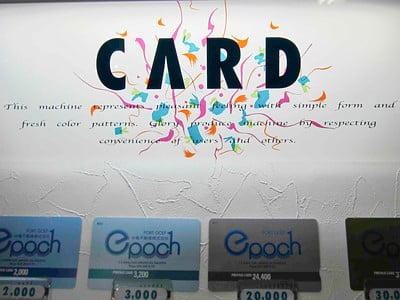
“Glory producing machine”
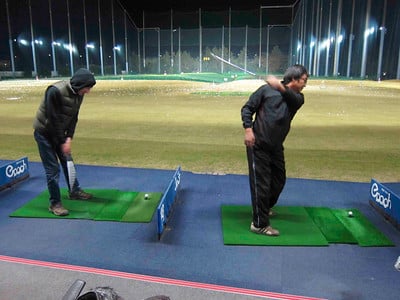
Intense competition on the range – brrr!
After proving that we aren’t the golfers we once were, we lit out for a late night snack – ramen. The evening made for a great finish to an outstanding trip. I can’t wait to go back!
Thanks for reading 🙂
Subscribe to Bonsai Tonight
New Posts Delivered Every Tuesday and Friday
Daniel Dolan says
Jonas:
Thank you for all of your informative posts. I have a very basic, though perhaps odd, question related to the subject of innovation in Bonsai….though it is related to Japanese culture at large.
Principally, in all of the Bonsai Exhibitions you visited did you encounter anything that would, either by your own standards or the standards of your Japanese colleagues, suggest something….new, different, radical, etc?
Again as a relative newcomer to Bonsai, 4 years, the photographs of winners of Kokufu-ten look like the identical trees that won for the past 50 years. I accept that they might be varied in some miniscule manner……but even to the educated eye they must seem to be essentially the same.
I can ask this more bluntly…..doesn’t anyone do anything differently? Aren’t there different approaches to Forest Groupings, Pots, Species for Bonsai [Has anyone ever seen a Japanese Larch Bonsai in Japan…..ever?
Very interested to know your thoughts.
Best regards,
D/D
Rusty says
Jonas, this is an awesome post – I am hoping to spend some time there this summer so this post helps. And I love Mochi!
Rusty
John says
DD, I think you need to go look at the pictures more carefully. I think that you can see a profound change in the trees from Kokufu-ten 55 onward, the early 80’s. The common theme of massive trees and massive trunks, etc, yes that is pretty common (oh the burden of having great material), however the approaches to managing foliage, the changes in staling from unruly (naturalistic) to highly stylized precision where not a needle or twig is out of place to a subtle presence of unruliness in some trees. I think Mike Hagedorn said it well in his Chojubai post a couple of months ago- and I paraphrase- if you don’t think things have changed in Japan overt the yeas, just go look at the Chojubai pictures over the past 20-30 years and how these plants have changed from generally sparse to uncannily full in just one generation.
Nice post Jonas, you seem to have had a marvelous time. Peter isn’t doing too bad himself. Though I think we all need to pitch in and get him a new winter hat…….
John
John says
staling=styling
yeas=years
Alex V says
I have to agree with John, when I first looked at the Kokufu books, they all looked the same, but the more I look at them, and good material in person, the less they look the same. There have definitely been big changes, such as the current trend to not show evergreens with wire on them versus having every twig wired a few years ago. They are still trees in pots yes, but the styling differences are pretty huge.
Jonas thanks again for the wonderful posts!
lightswimming says
great story and pics. loved the sea of bonsai!
LSBonsai says
I think the problem is that in the west it is hard to get ahold of the old kokufu books. When I visited Aichi-en in December, I was lucky to be able to browse Mr. Tanaka’s seemingly complete library of kokufu albums. It is incredible how much the styling trends, species trends, and quality of development of trees in kokufu have changed over a few decades.
Even looking at this years kokufu prize winners, there is a ton of diversity.
Now DD: I know your question was mainly about innovation. What do you consider to be innovation in bonsai?
Jonas Dupuich says
Hi Daniel – fun question! John, Alex, and Lakeshore Bonsai all make great points. I have a number of Kokufu and other show books and I wish that everyone in bonsai had access to at least one – they are the best resource I know of for styling guidance.
It’s clear that bonsai has benefitted from a number of technical innovations over the years (decandling, chainsaws, etc.) but it’s harder to point to specific stylistic innovations. One reason might be that bonsai takes so many of its stylistic cues from nature.
That said, fashions definitely come and go in the bonsai world. A decade or so ago, deadwood in exhibits was often bright white and even the smallest branches on conifers were wired to create “perfect” silhouettes. These days deadwood is more subtle and conifers sport more relaxed silhouettes.
Other departures from the norm may include Kimura’s rock plantings, the use of new and stylish pots, or the display of bonsai in concert with paintings, photographs or automobiles (cf. Walter Pall).
I’d love to see more diverse varieties at bonsai exhibits. Popular varieties like pines, maples and junipers have great characteristics for bonsai, but so do a number of other trees – maybe in time we’ll see more varieties that simply aren’t present in Japan.
Jonas
Roy Yamashiroya says
Aloha Jonus,
I’m the Hawaiian guy helping Tohru Suzuki and Dennis Makishima. Whenever Tohru does a demo in another country which I’m attending, he always ask if I can assist him. It is an honor and previlege to be on the same stage with him. He have taught me over the years that I’ve knowned him, the many techniques in maintaining and styling bonsai. I also know Junichiro Tanaka, Tohru’s son-in-law who got married in Hawaii, and also knew his father. You trained under one of the up and coming bonsai master in Japan, and I no you will be great master one day.
Mahalo,
RY
Jonas Dupuich says
Thanks Roy!